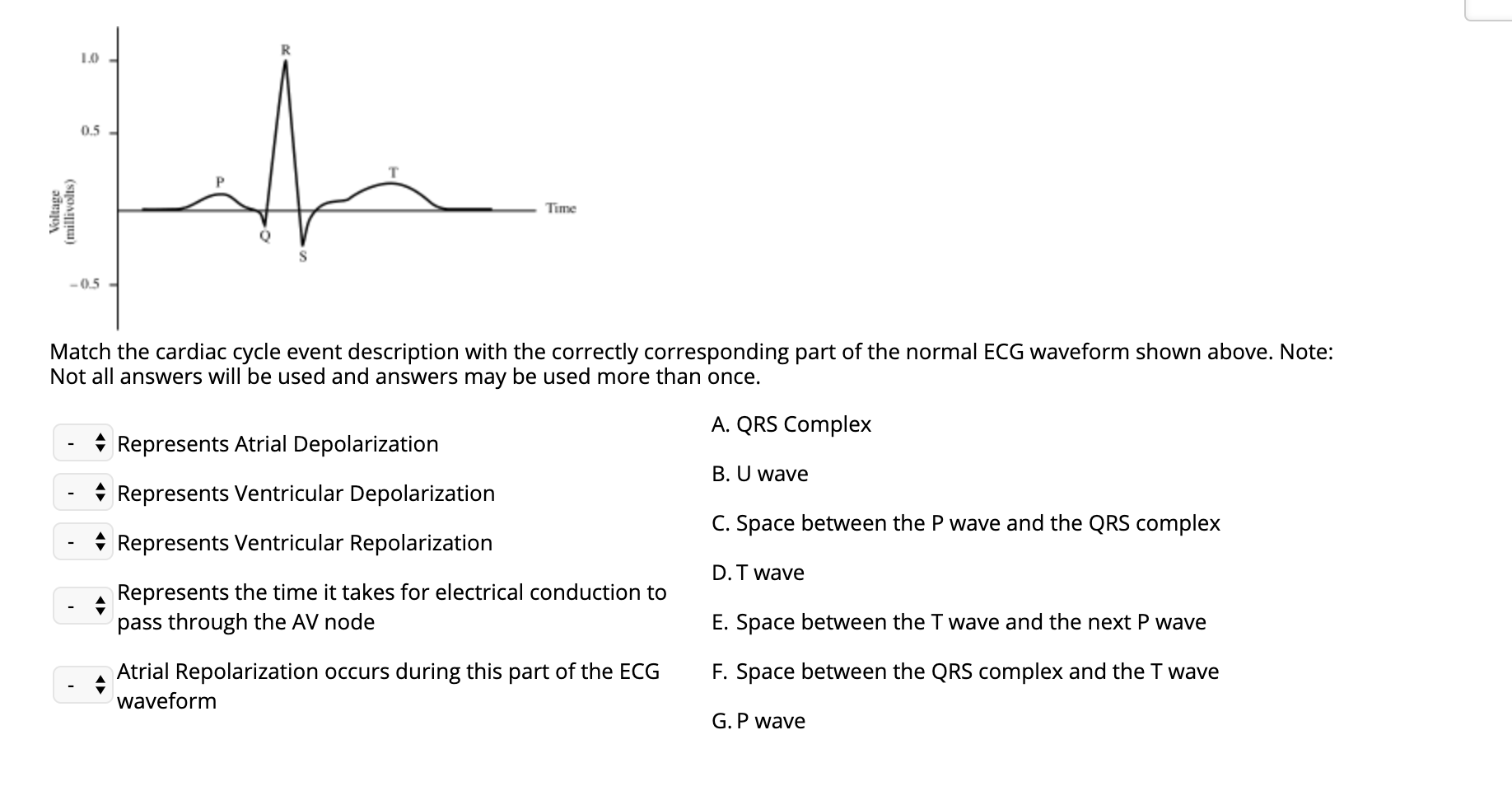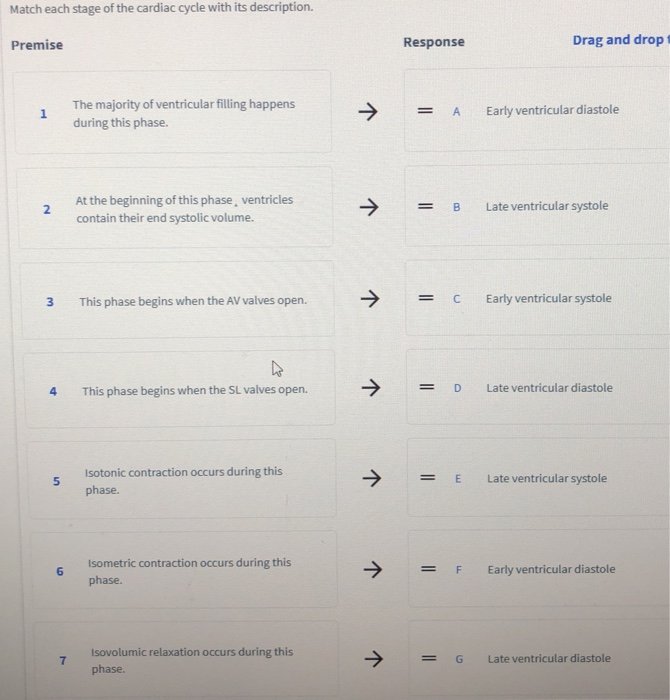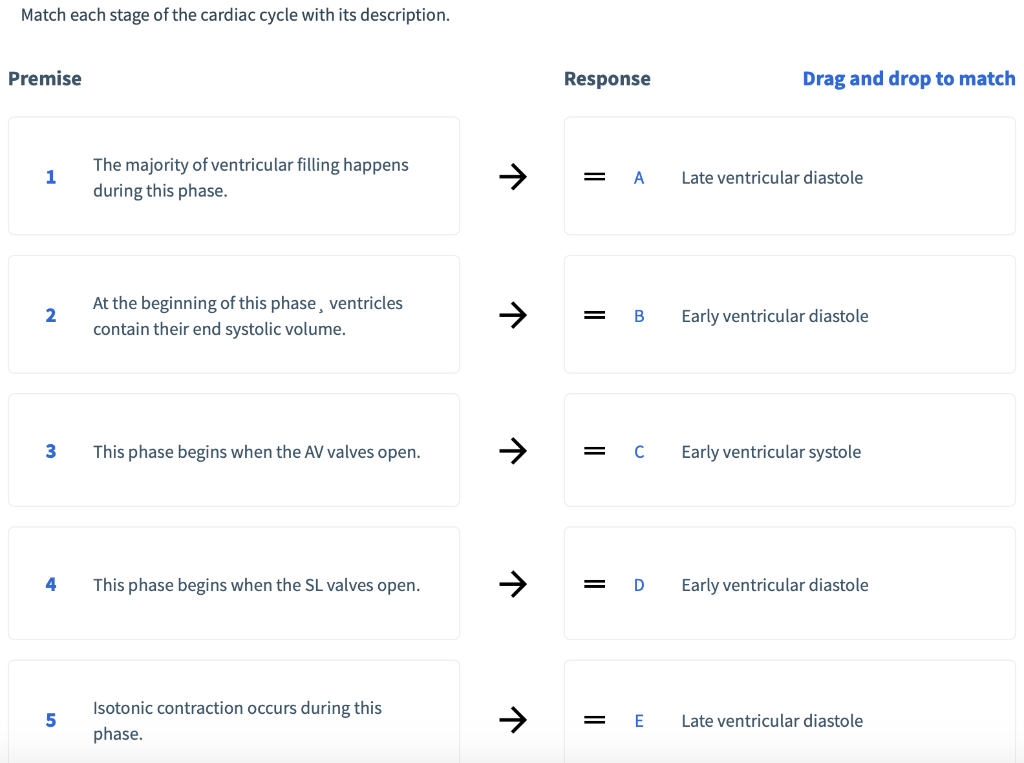Match the Cardiac Cycle Event With the Correct Ventricular Activity.
Match the following ventricular cardiac cycle event with the correct characteristics decrease in pressure no change volume minor change in pressure decrease in volume relatively little change in pressure increase in volume increase in pressure increase in volume increase in pressure decrease in volume Isovolumetric Contraction decrease in. Ventricular filling occur during diastole.

Solved Match The Following Event With The Correct Phase Of Chegg Com
Atria and ventricles relax A.

. Match the component of the electrocardiogram to the correct definition. It consists of two parts. Match each description with a correct cardiac cycle stages.
Factors Affecting Blood Pressure Work through the IP 20 presentation on Factors That Affect Blood PressureThen complete the questions and activities below. Ventricular relaxation called. Anatomy and Physiology questions and answers.
Match each description with a correct cardiac cycle stages. It has many phases. Match the cardiac cycle event with the correct ventricular activity.
Cardiac diastole Part B. Ventricular systole B 3. The period of contraction that the heart undergoes while it pumps blood into circulation is called systole.
Match the cardiac cycle event with the correct ventricular activity. Examine diagrams and determine a correct phase of cardiac cycle based on the flow of the blood. Both the atria and ventricles undergo systole and.
Cardiac diastole Activity 2. Atrial systole C 2. You may take notes on the diagrams below.
Atrial systole A 2. Ventricular systole B 3. Match each description with a correct cardiac cycle stages.
The correct sequence of events will be. These pressure changes originate as conductive electrochemical changes within the myocardium that result in the concentric contraction of cardiac muscle. With all valves closed.
Cardiac Diastole B 2. Passive ventricular filling 4. This phase marks the beginning of systole and starts with the appearance of the QRS complex on the EKG and the closure of the AV valves at point a.
Atria and ventricles relax A. Match the cardiac cycle event with the correct ventricular activity. The dye-labeled blood has been colored light here to make it more visible.
Each part of the cardiac cycle consists of several phases characterized by either. These pressure changes result in the movement of blood through different chambers of the heart and the body as a whole. AV valves are open Ventricular systole incorrect Semilunar valves are open Ventricular diastole incorrect First heart sound Ventricular systole correct Second heart sound Ventricular diastole correct Third heart sound Ventricular systole incorrect.
Part A Match the terms in the left column to the blanks near their definition on the right. Quiz Questions 3a 4a 5a 6a. Cardiac Cycle Part A.
The Beating Heart Activity 1. Cardiac diastole Part B. Rhythmic heart beat is maintained by a highly specialized excitatory and conductive system.
The beginning of ventricular systole is when blood flowing back toward the relaxed ventricles causes the semilunar valves to close. Cardiac Cycle Part A. Drag the activities to the phases corresponding to the numbers at different points on the graph.
The period of relaxation that occurs as the chambers fill with blood is called diastole. Examine diagrams and determine a correct phase of cardiac cycle based on the flow of the blood. Ventricular contraction called.
Part E - Events in the Cardiac Cycle Match each phrase to its corresponding position within the figure. T he cardiac cycle represents the hemodynamic and electric changes that occur in systole and diastole. The duration of cardiac cycle is.
Match the cardiac cycle event with the correct ventricular activity. The ventricular diastolic stage involves blood flow from the atria to the ventricles and the ventricular systole includes blood flow from the ventricles to the pulmonary artery and the aorta. Match the following ventricular cardiac cycle event with the correct characteristic s Isovolumetric Relaxation Ventricular Filling Isovolumetric Contraction Ventricular Ejection 1 I minor change in pressure decrease in volume decrease in pressure increase in volume decrease in pressure decrease.
Isovolumetric ventricular contraction a-b. Phases of the Cardiac Cycle. Duration of one cardiac cycle is O8 seconds.
Cardiac Cycle Part A. The period of timethat begins with contraction of the atria and ends with ventricular relaxation is known as the cardiac cycle Figure 1931. Cardiac cycle is the term referring to all of the events that occurs from the beginning of one heartbeat to the beginning of the next.
AV valves are open 2. Semilunar valves are open 3. Second heart sound 5.
The cardiac cycle The cardiac events occur from the beginning of one heart beat to the beginning of next heart beat. The steps of the cardiac cycle in sequence are isovolumic contraction ejection isovolumic relaxation passive ventricular filling active ventricular filling. First heart sound 4.
Quiz Question 3b 4b 5b 6b. Match the correct response of blood vessels in the skin to the event. Identify cardiac conduction features that correspond to labels C 1.
The cardiac cycle is a period from the beginning of one heart beat to the beginning of the next one. P wave - Atrial depolarization QRS complex - Ventricle depolarization T wave - Ventricle re-polarization PQ PR interval - equates to atrial systole QT interval - equates to ventricular systole Correctly label the parts of a normal electrocardiogram. The time taken to complete one cardiac cycle is 08 sec and is called cardiac cycle time.
It is initiated by spontaneous generation of action potential in SA sinoatrial node. Cardiac Cycle Phase These question asks you to view a diagram of the heart and predict what stage of the cell cycle its in. The cardiac cycle is a series of pressure changes that take place within the heart.
Period of isovolumetric relaxation 3. Mechanical events of the cardiac cycle 1Atrial systole. The Beating Heart Activity 1.
The cardiac cycle is a series of electrical and mechanical events that occur during the phases of heart relaxation diastole and contraction systole. Some events of cardiac cycle are as follows. Match the following ventricular cardiac cycle event with the correct characteristics Isovolumetric Contraction Isovolumetric Relaxation Ventricular Filling Ventricular Election Match the following ventricular cardiac cycle event with the correct characteristics Isovolumetric Contraction Isovolumetric Relaxation minor change in pressure decrease in.
The frequency of the cardiac cycle is the heart rate. Period of isovolumetric contraction 2. Examine diagrams and determine a correct phase of cardiac cycle based on the flow of the blood.

Solved Voltage Millivolts Time Match The Cardiac Cycle Chegg Com

Solved Match Each Stage Of The Cardiac Cycle With Its Chegg Com

Solved Match Each Stage Of The Cardiac Cycle With Its Chegg Com
No comments for "Match the Cardiac Cycle Event With the Correct Ventricular Activity."
Post a Comment